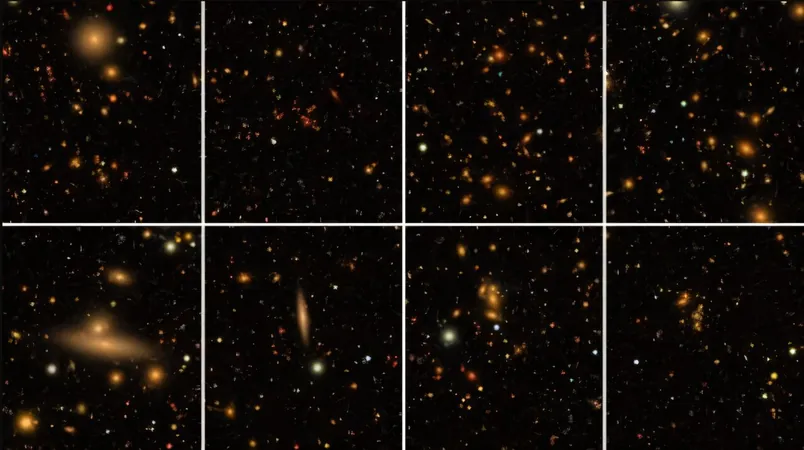
Unveiling the Universe: Groundbreaking Sky Survey Set to Revolutionize Understanding of Dark Matter and Dark Energy
2024-11-01
Author: Daniel
Introduction
In the serene heights of northern Chile, groundbreaking advancements are underway at the NSF–DOE Vera C. Rubin Observatory, poised to become one of the most advanced astronomical facilities ever constructed. With a cutting-edge telescope and the world’s largest digital camera, this observatory is gearing up for the Legacy Survey of Space and Time (LSST)—a monumental 10-year project aiming to reshape our understanding of the cosmos.
The LSST and Its Impact
The LSST will capture a staggering 5.5 million detailed images of our night sky, surpassing the data accumulated from all prior astronomical surveys combined. This unprecedented volume of information is set to illuminate some of the universe's most profound mysteries, particularly those surrounding dark matter and dark energy, two enigmatic components that together constitute approximately 95% of the cosmos.
The LSST Dark Energy Science Collaboration
At the forefront of this exploration is the LSST Dark Energy Science Collaboration (DESC), featuring researchers from the Department of Energy's Argonne National Laboratory. They are focused on unraveling the elusive nature of dark matter and dark energy through sophisticated cosmological simulations. These predictive models help scientists imagine different scenarios regarding the origins and behavior of these cosmic phenomena.
“Currently, we lack definitive insights into the physical origins of dark matter and dark energy, but with our theories and the LSST, we are optimistic about gaining much-needed constraints," says Katrin Heitmann, deputy director of Argonne's High Energy Physics division. “This will guide our community toward the most promising questions to investigate.”
Data Processing and Supercomputing
The simulations being run at Argonne are not just theoretical; they are designed to forecast observable consequences that could emerge from real data collected by the LSST. For instance, researchers are investigating how slight temperature variations in dark matter or fluctuations in dark energy during the universe's infancy could influence its present structure. Each simulation affords critical insights—showing potential changes in galaxy formations or indicative events that the LSST might detect.
To process the colossal volume of data, Argonne scientists harness the incredible power of the Argonne Leadership Computing Facility (ALCF). Within this hub lies Aurora, one of the world’s first exascale supercomputers, capable of executing more than one quintillion calculations per second. “Thanks to Aurora’s exceptional capacity, we can simulate larger cosmic volumes with finer detail than ever before,” Heitmann adds.
Transforming Light to Data
As light from distant galaxies reaches the observatory, it will be transformed into data by advanced sensors on its digital camera and transmitted to data facilities worldwide for analysis. The LSST will generate a whopping 60 petabytes of image data—an amount equivalent to 60 million gigabytes. To put this into perspective, it would take over 11,000 years of non-stop Netflix-watching to sift through that much information.
Challenges in Data Analysis
Argonne physicist Matthew Becker and his team are instrumental in processing this data effectively. They’re developing algorithms that will help penetrate the slight gravitational lensing signals created by dark matter, which subtly distort the shapes of galaxies as light from distant stars travels towards our observatory. This technique could reveal crucial details about the cosmic arrangement and distribution of dark matter.
However, the challenge lies in the faintness of these signals. The anticipated signal strength from weak gravitational lensing will be roughly 30 times weaker than the inherent noise in the data, necessitating a colossal amount of information for accurate analysis. Becker is working to streamline this data, merging images to identify faint correlations and enhance findings.
Conclusion
The excitement surrounding the LSST cannot be understated. With its completion, the landscape of cosmology is about to shift dramatically as researchers gain unprecedented insights into the universe’s structure and the deepest mysteries of dark energy and dark matter. "Once we dive into this data, the universe will reveal secrets we've only begun to ponder," Becker enthused.
As this ambitious sky survey prepares for liftoff, scientists worldwide are on the edge of their seats, eager to unlock the secrets of our universe hidden in the dark!



 Brasil (PT)
Brasil (PT)
 Canada (EN)
Canada (EN)
 Chile (ES)
Chile (ES)
 Česko (CS)
Česko (CS)
 대한민국 (KO)
대한민국 (KO)
 España (ES)
España (ES)
 France (FR)
France (FR)
 Hong Kong (EN)
Hong Kong (EN)
 Italia (IT)
Italia (IT)
 日本 (JA)
日本 (JA)
 Magyarország (HU)
Magyarország (HU)
 Norge (NO)
Norge (NO)
 Polska (PL)
Polska (PL)
 Schweiz (DE)
Schweiz (DE)
 Singapore (EN)
Singapore (EN)
 Sverige (SV)
Sverige (SV)
 Suomi (FI)
Suomi (FI)
 Türkiye (TR)
Türkiye (TR)
 الإمارات العربية المتحدة (AR)
الإمارات العربية المتحدة (AR)